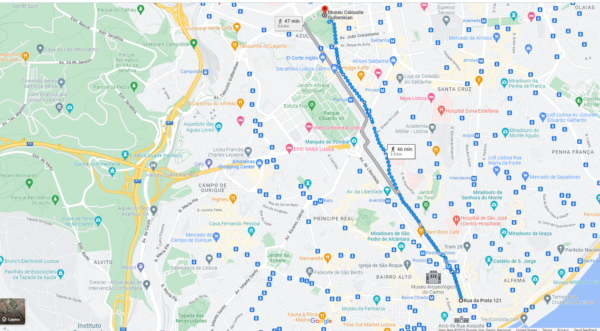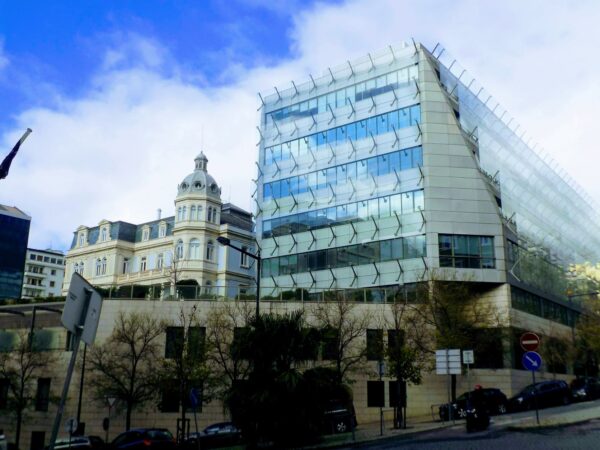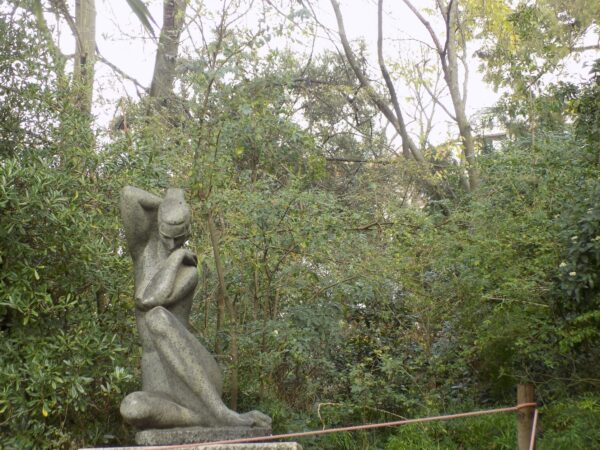It took me a few minutes to identify what felt different about this Monday morning. It wasn’t the weather which was again gray – though the forecast predicted a break in the gloom for early afternoon. As I wiped the sleep out of my eyes, I realized that today would be my last full day in Lisboa and the only certainties in my plans were to finish as much of the food in the flat as I could, load my Viva Viagem card for the Metro ride to the airport Tuesday morning, and spend as many of my remaining euros as possible.
Finishing the food started with another omelet. On my trip to Pingo Doce, I’d bought a small package of smoked salmon specifically for this purpose. I sautéed some leftover onion and red bell pepper to complete the dish. I did leave Sérgio a little rice and I had to toss a bit of bread that had gotten moldy but all in all I thought I’d managed my food purchases quite well. Lunch was even less of a challenge. I finished the pizza I’d brought home last night.
On a Clear Day
By the time I finished lunch, the low hanging gray clouds had vanished and, while some higher, fluffier clouds remained, the sun made its first appearance in two days. I decided I’d walk up to the Calouste Gulbenkian Museum and Garden.

It was a 3.5 km walk through parts of the city that were both familiar and unfamiliar as the Google maps screen capture shows.
Calouste Gulbenkian was a British Armenian business man who helped arrange the merger of Royal Dutch Petroleum Company with Shell Transport and Trading Company Ltd. He took a five percent stake in the new Royal Dutch Shell, Ltd. and amassed a fortune by doing so. His wealth grew from his significant role in opening the petroleum reserves of the Middle East to Western development.
As Gulbenkian grew wealthier, he assembled a geographically and temporally diverse eclectic collection of art exceeding 6,000 pieces encompassing art from ancient Egypt, ancient Greece, Babylonia, Armenia, Persia, Europe, and Japan. His collection includes a significant amount of Islamic art and has paintings by Carpaccio, Rubens, Van Dyck, Frans Hals, Rembrandt, Guardi, Gainsborough, Fragonard, Corot, Renoir, Manet, Degas, Monet and others.
Although he had British citizenship and had built several residences in France – including one in Paris and one in Deauville –

(Wikimedia Commons – Public Domain)
he left the latter country in late 1942. He moved to Lisboa seeking refuge from the war and lived there in a suite in a luxury hotel until his death in 1955.
Gulbenkian wanted to preserve his collection in one place but for personal reasons he mistrusted the British government and he failed to reach an agreement with both the French governments and the National Gallery of Art in Washington, DC before his death. His lawyer, Lord Radcliffe, had to settle the issue.
In 1960, the entire collection was brought to Portugal for an exhibition at the Palace of the Marquês de Pombal in Oeiras just west of Lisboa. It remained there until the Calouste Gulbenkian Museum – built specifically to house his collection – opened in Lisboa in 1969.
Rise and look around you
One element absent from Organic Maps (or one that I haven’t found) is the inclusion of elevation changes. The walk to and through Praça Figueira is quite flat but once I passed Rossio, I began to climb. And it felt as though the remaining three kilometers were all uphill.
Although I used my Organic Maps app, I think the route was the same as or very similar to the one on the map above. This meant that the area up to the Avenida Metro was quite familiar because I’d stayed there in May. Once I reached the section west of Parque Eduardo VII, I was in terra incognita.
I didn’t take many photos along the way in part because my mind wasn’t as focused as it would normally be and in part because I was traipsing mainly along side streets that I found rather uninteresting. There was, I thought, one curious architectural juxtaposition,

though I neither knew nor made any effort to discover the identity of the two buildings.
I felt like I’d been walking uphill for an hour – and even if that wasn’t precisely true, my thighs were screaming at me as though it was. But more persistent than that was the nagging sense that I was missing something. Shortly before I reached my destination it came into focus. I was sad that this second Monday would be my last.
By the time I reached the garden, my primary thought was to sit and rest. While resting, the unbidden thought came that between my tired legs and my wistful state of mind, I needed no one to tell me why I don’t like Mondays or, more specifically, this Monday.
I mustered the energy to traverse most of the garden that had some sculptures that were representational

and others that were not.

Ultimately, I chose not to go into the museum because I was too tired to appreciate the art I’d see. Instead, I walked the kilometer or so to the Campo Pequeno Metro stop and rode rather than walked back to Baixa.
A farewell dinner and flight confusion
As I’ve noted previously Portugal has historical ties to India and this contributes to Lisboa having many restaurants specializing in Indian cuisine. I’d been to Caxemira a few nights earlier and decided to sample another – Swaagat – that was closer to the flat.
As I expected, although a few tables were occupied and more would come to be so, the restaurant was uncrowded when I arrived at about 19:00. The meal – vegetable samosas, chicken bengan, and a Cobra beer was not only delicious but cost less than €20. However, the most striking aspect of the evening for me was what happened with other diners who were sitting near me.
Two women were sitting at a table to my right speaking German. At the table immediately to my left, two women who came in shortly after I did were speaking Korean. When our server, who, if he wasn’t from India, was clearly from the sub-continent, came to take our order, we all interacted with him in English. Here were two Germans, two Koreans, and an American in an Indian restaurant in Lisboa with an Indian server all ordering their dinners in English. This not only reinforced the good fortune of being a native English speaker but also the idea that, at least in this neighborhood, Portuguese fluency wasn’t crucial.
In the first post of this series, I wrote of my departure, “flying without some degree of complication in the third decade of the 21st century is becoming increasingly rare and this trip was no exception.” The complication affecting my return was even worse. My flight was supposed to depart Lisboa for JFK at 10:00 Tuesday morning. This meant I had a reasonable amount of time to get up, make certain everything was in order, and take the 40 minute Metro ride to the airport.
At 02:00, my phone started chirping. Text. Email. Text. Text. I had to look and it’s good that I did. Some issue had arisen delaying my departing flight so long that I’d miss my connection from New York to Baltimore. I spent the next 40-50 minutes in text exchanges with Delta trying to reschedule. They managed to book me on a British Airways flight to Heathrow with a connection directly to Baltimore.
There remained an additional complication. The flight had an 08:30 or 09:00 departure and I’d have to check-in at the airport because they couldn’t issue my ticket or boarding pass electronically. I was too wired to sleep and was outside the gate at the Baixa-Chiado station

(From thelisbonconnection.com)
at 06:25 waiting for the Metro to open at 06:30.
The train was on time and with a 2 or three minute walk into the departures terminal, I was in line at BA by about 07:40. Clearly, everything worked out although the flight from Heathrow to Baltimore had some sort of mechanical delay. I arrived at BWI about 20:00 and was home by 20:45
As for the great experiment, I can say that the attraction I felt for Lisboa in May became a feeling of attachment in December / January. The knowledge that I could live without an immediate mastery of Portuguese and the casual nature of Ana’s text messages made me feel that I’d already become a part of the city. As I write this, I plan to return at the end of 2023 for an extended stay. After that…who knows.
And here are the trip’s few final pictures.
NOTE: The Music for Charities Challenge is now open. For those who have my email, please submit your entries using that method. You can also submit entries or request my email by a direct message to me on Twitter: @TCarton_isFHFAN.